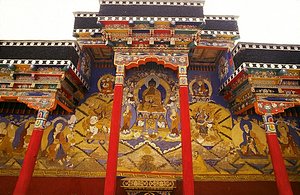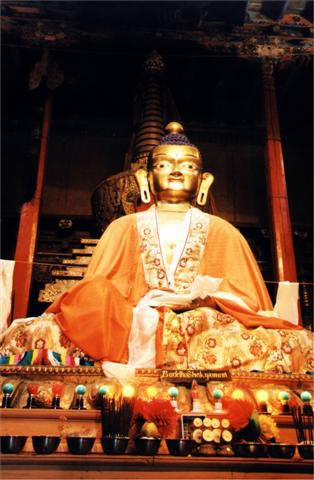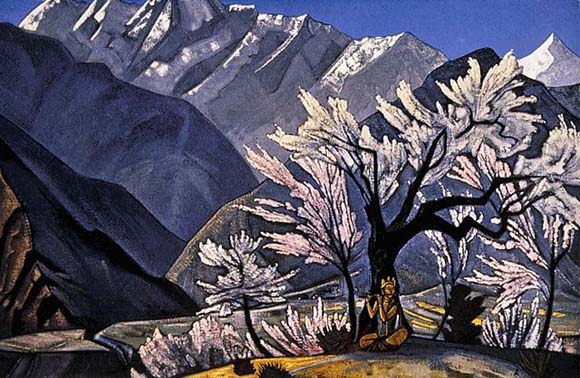Jesus in India
BY: SUN STAFF

Dec 03, USA (SUN) — In his book entitled "The Unknown Life of Christ", published in 1894, Nicholas Notovitch published the findings of his life study and experiences concerning Jesus Christ's travels to India. Born in 1858 into a wealthy Russian family in the Crimea, Notovitch converted from Judaism to Eastern Orthodox when he was quite young. He later became a journalist and political writer who did a great deal of traveling.
In 1877, Notovitch undertook a journey to India, “to study the customs and habits of the inhabitants of India amid their own surroundings, as well as the grand, mysterious archæology and the colossal, majestic nature of the country”. “Wandering” about the land, traveled through Afghanistan, what is now Pakistan, Northern India, Kashmir and finally arrived in Ladakh, India.

While in Ladakh, which is sandwiched between Kashmir and Tibet, Notovitch fell from his horse and was injured. The Buddhist monks from the Hemis monastery who cared for him, and it was through this relationship that he learned of the proof that Christ had, in fact, spent time in India.
One of the Lamas at Hemis that Notovitch became friendly with produced a number of ancient scrolls written in Tibetan by Buddhist historians. An interpreter translated the scrolls, and Notovitch managed to make copies of a significant portion of them. The scrolls narrate the story of Jesus (identified as "Issa") from birth to death. But most significantly, the scrolls tell of Christ’s travels between the ages of 13-30.
According to the Hemis scrolls, Christ came specifically to study the teachings of the Buddhists. His travels took him through Sindh, the Punjab and eventually to Juggernaut, where he studied the Vedas. The scrolls also indicate that Jesus was driven out of the temples when he taught the Holy Scripture to those whom the local Brahmins thought unworthy, and when Jesus spoke out against caste distinction. The Hemis Lamas noted:
"We also respect the one whom you recognize as Son of the one God. The spirit of Buddha was indeed incarnate in the sacred person of Issa [Jesus], who without aid of fire or sword, spread knowledge of our great and true religion throughout the world. Issa is a great prophet, one of the first after twenty-two Buddhas. His name and acts are recorded in our writings."

Lord Buddha at Hemis
According to the scrolls, Jesus took shelter in the Gothamide region, where he continued his studies until the age of 29, when he returned to Judæa. The scrolls go on to document details of Christ's life, including the story of his eventual death on the cross.
Srila Prabhupada clearly accepted Christ's position as a pure representative of Lord Krsna, and an advanced guru of Krsna Consciousness. In Science of Self Realization, chapter 4, he wrote:
"Jesus Christ was such a great personality--the son of God, the representative of God. He had no fault. Still, he was crucified. He wanted to deliver God consciousness, but in return they crucified him--they were so thankless. They could not appreciate his preaching. But we appreciate him and give him all honor as the representative of God.
Of course, the message that Christ preached was just according to his particular time, place, and country, and just suited for a particular group of people. But certainly he is the representative of God. Therefore we adore Lord Jesus Christ and offer our obeisances to him.
Once, in Melbourne, a group of Christian ministers came to visit me. They asked, "What is your idea of Jesus Christ?" I told them, "He is our guru. He is preaching God consciousness, so he is our spiritual master." The ministers very much appreciated that.
Actually, anyone who is preaching God's glories must be accepted as a guru. Jesus Christ is one such great personality. We should not think of him as an ordinary human being. The scriptures say that anyone who considers the spiritual master to be an ordinary man has a hellish mentality. If Jesus Christ were an ordinary man, then he could not have delivered God consciousness."
Scholars of Christ's lost years have put great study in the derivation of the various names used for Jesus. “Isa”, or “Issa”, is said to derive from the Syrian, Yeshu (Jesus), “being altered to conform to Musa (=Moses).” Interestingly, Jesus is referred to as “Issa” in the Buddhist Hemis scrolls, as “Isa” in the Quran, and as “Isa” in the Hindu sastra, Bhavishya Mahapurana. That the religious documents of these three religions mention Jesus as “Isa” suggests that this was actually a name by which he was known in the East.
While recovering from the broken leg he got during the fall from his horse, Notovich asked to see the manuscripts describing Jesus in India, and the monks brought two books with loose, yellowed leaves to his bedside. As the monks read these documents to Notovitch an interpreter translated, and Notovitch took notes. Following are a few excerpts from these texts:
"It was then that Issa clandestinely left his father's house, went out of Jerusalem, and, in company with some merchants, traveled toward Sindh, that he might perfect himself in the divine word and study the laws of the great Buddhas. In the course of his fourteenth year, young Issa, blessed by God, journeyed beyond the Sindh and settled among the Aryas in the beloved country of God. The fame of his name spread along the Northern Sindh. When he passed through the country of the five rivers and the Radjipoutan, the worshippers of the God Djaine begged him to remain in their midst.
"But he left the misguided admirers of Djaine and visited Juggernaut, in the province of Orsis, where the remains of Viassa-Krichna rest, and where he received a joyous welcome from the white priests of Brahma.
"They taught him to read and understand the Vedas, to heal by prayer, to teach and explain the Holy Scripture, to cast out evil spirits from the body of man and give him back human semblance. He spent six years in Juggarnaut, Rajegriha, Benares, and the other holy cities; all loved him, for Issa lived in peace with the Vaisyas and the Soudras, to whom he taught the Holy Scripture.
"But the Brahmans and the Kshatriyas declared that the Great Para-Brahma forbade them to approach those whom he had created from his entrails and from his feet. That the Vaisyas were authorized to listen only to the reading of the Vedas, and that never save on the feast days.
"That the Soudras were not only forbidden to attend the reading of the Vedas, but to gaze upon them even, for their condition was to perpetually serve and act as slaves to the Brahmans, the Kshatriyas, and even to the Vaisyas. 'Death alone can free them from servitude,' said Para-Brahma. 'Leave them, therefore, and worship with us the gods who will show their anger against you if you disobey them.'
"But Issa would not heed them; and going to the Soudras, preached against the Brahmans and the Kshatriyas. He strongly denounced the men who robbed their fellow-beings of their rights as men, saying, 'God the Father establishes no difference between his children, who are equally dear to him...
"'The wrath of God shall soon be let loose on man, for he has forgotten his Creator and filled his temples with abominations, and he adores a host of creatures which God has subordinated to him. For, to be pleasing to stones and metals, he sacrifices human beings in whom dwells a part of the spirit of the Most High.
"For he humiliates them that labor by the sweat of their brow to gain the favor of an idler who is seated at a sumptuously spread table. They that deprive their brothers of divine happiness shall themselves be deprived of it, and the Brahmans and the Kshatriyas shall become the Soudras with whom the Eternal shall dwell eternally.
"For on the day of the Last Judgment, the Soudras and the Vaisyas shall be forgiven because of their ignorance, while God shall visit his wrath on them that have arrogated his rights.'
"The Vaisyas and the Soudras were struck with admiration, and demanded of Issa how they should pray to secure their happiness. 'Do not worship idols, for they do not hear you; do not listen to the Vedas, where the truth is perverted; do not believe yourself first in all things, and do not humiliate your neighbor. Help the poor, assist the weak, harm no one, do not covet what you have not and what you see in the possession of others.'"
(Ibid, pgs. 34-35)
After making the Brahmin priests furious with his preaching, Jesus left Juggarnaut in the dead of night and traveled to the Gothamide country, where he learned the Pali language and studied the Buddhist scriptures. Later, he traveled back towards his birthplace, preaching along the way and defended the rights of the oppressed while arguing with the priestly class. In Persia, the Persian Zoroastrian priests expelled him for being a nuisance, hoping that he would be eaten by wild beasts. Finally he reached Palestine at the age of 29 having been gone so long that no one knew who he was.
Notovitch believed he had discovered the most powerful written manuscripts of the age. He wrote:
"Entertaining no doubt of the authenticity of this narrative, written with the utmost precision by Brahmin historians and Buddhists of India and Nepal, my intention was to publish the translation on my return to Europe. With this object in view, I addressed myself to several well-known ecclesiastics, requesting them to revise my notes and tell me what they thought of the matter.
"Monseigneur Platon, the celebrated Archbishop of Kiev, believed my discovery to be of great importance, but he earnestly tried to dissuade me from giving the memoirs publicity, declaring it would be against my own interests to do so. Why? This the venerable prelate refused to explain. Our conversation, however, having taken place in Russia where censorship would have placed its veto on a work of this kind, I determined to wait. A year later I chanced to be in Rome. Here I submitted the manuscript to a cardinal standing high in the estimation of the Holy Father.
"'Why should you print this?'" he said, didactically; 'nobody will attach much importance to it, and you will create numberless enemies thereby. You are still young, however. If you need money, I can obtain some compensation for these notes, enough to remunerate you for your loss of time and expenditure.' Naturally enough, I refused the offer.
"In Paris I laid my project before Cardinal Rotelli, whom I had met in Constantinople. He also opposed the publication of my work, under pretext that it would be premature. 'The church,' he added, 'suffers too deeply from this new current of atheistic ideas, and you would only furnish new food to the calumniators and detractors of the evangelical doctrine. I tell you this in the interest of all Christian churches.' I then called on M. Jules Simon, who found my communication most interesting and advised me to consult M. Renan in regard to the best means of publishing these memoirs.
"The very next day I found myself seated in the study of the great philosopher. At the end of the interview M. Renan proposed that I should entrust him with the memoirs in question, that he might make a report on them to the Academy. This proposition, as the reader will understand, was most deductive and flattering. Yet I took away the work with me, saying I wished to revise it once more-- the fact being that I feared if I accepted this association I would only receive the bare honor of discovering the chronicles, while the illustrious author of 'The Life of Jesus,' would reap the glory of the publication and of the commentaries. Believing myself sufficiently prepared to publish the narrative by adding my own notes, I finally declined the courteous offer made to me. That I might not, however, wound the feelings of the great master, whom I deeply respected, I resolved to await his death, which could not be far off, judging from his feebleness. Soon after the death of M. Renan, I wrote to M. Jules Simon, and again sought his advice. His reply was that I should judge for myself the expediency of giving publicity to the memoirs."
(Ibid, pgs. 10-11)
Not surprisingly, the great majority of Christian scholars deny Notovitch's evidence as false, while others more inclined to see the wider story of Christianity accept it cent percent. This evidence is not proved solely by Notovitch's writings, however. Numerous others also visited the Hemis monastery over the years, and also reported having seen the Jesus scrolls.
Following is a list of some of those, besides Notovitch, who traveled to Hemis and saw the documents, or who read other ancient Indian documents mentioning Jesus in India:
Swami Abhedenanda (1922)
Nicholas Roerich (1925)
Madame Caspari (1939)
Mrs. Clarence Gasque (1939)
Sri Bharati Krishna Tirtha
Many others have also reported hearing oral references to the documents. Swami Abhedananda of the Ramakrishna Society traveled to Hemis after reading Notovitch's book, and challenged the Lamas there to confirm or deny what Notovitch had reported. The swami was shown a manuscript described by the Lamas as a translation into Tibetan of the original manuscript, which was by then in a monastery at Marbour, near Lhasa. Abhedananda made his own translation of the manuscript, and it closely matched the content provided by Notovitch. Abhedananda later published his translations of the "Issa Scriptures in Kashmir O Tibbate" (In Kashmir and Tibet).

Krishna Kulu Valley by Nicholas Roerich
The famous and widely respected expatriate Russian artist and intellectual, Nicholas Roerich, also visited the Hemis monastery, in 1925, and later published his account in "Heart of Asia" and "Altai-Himalaya". Roerich became famous for his ethereal series of paintings of the Himalayas, which included reference to Lord Krsna.
The Hemis manuscripts about Jesus are also confirmed by a Hindu source. The scrolls said Issa spent six years in Jagannath (Puri) and other holy cities of the Hindus, before going to live for a further six years in the Himalayas. In a 1959 interview, His Holiness Sri Bharati Krishna Tirtha, the Shankaracharya of Puri, said "I have studied ancient records in the Puri Jagannath Temple archives confirming those facts. He was known as "Isha," and during part of his time in India he stayed in the Jagannath Temple. When he returned to his part of the world, he expounded the teachings that are known today as Christianity."
